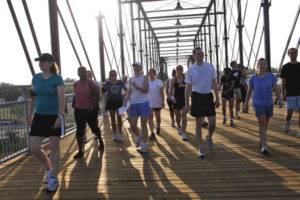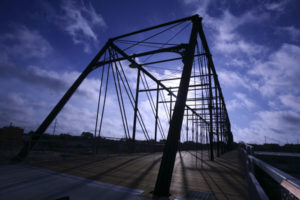Want to see the future and current projects that are transforming San Antonio’s central city? Check out this amazing new website that was recently launched. This is a comprehensive list with lots of wonderful information and photos. Thank you for your tremendous effort, Todd Morey and Lorenzo Gomez. Urbantonio.
Front Porch Realty, LLC is now open for business
I’ve recently opened my own agency and today the new signs are out. Let me know your thoughts on the new (albeit temporary) design. I’m working with my Graphic Designer on a whole branding and design package. More to follow.

Front Porch Realty, LLC
Running through East Side History
I took part in the King Willliam/Lavaca 5K History Run back in May and was embarrassed at my lack of ability to keep up with the runners. It has clearly been years since my days of running track in high school!! I wish I would have known there were multiple groups on this “run.” I would have taken the “moms with strollers” walk!
San Antonio’s Office of Historic Preservation is doing a great job of engaging the public and creating fun events to learn about this city’s history.
This is a nice write-up of the event by John Tedesco with the Express-News.
There are many ways to learn about a city and its history — but not many involve putting on a jogging outfit and trying to keep up with Amy Unger.
On Saturday, about 45 people showed up for a three-mile run through the East Side near downtown, which offered a unique perspective of a struggling neighborhood that many people simply glimpse at on their way to Spurs games.
“I’ve lived in San Antonio my entire life and really don’t know anything about the neighborhood,” said jogger Sarah Deosdade.
Unger and her other fit colleagues at the city’s Office of Historic Preservation have been leading runners on tours through historic parts of San Antonio. They started the free program in May, Historic Preservation Month.
District 2 Councilwoman Ivy Taylor invited the city’s history experts to explore the East Side, home of the grand houses of Dignowity Hill and the recently restored Hays Street Bridge.
Participants gathered at the Carver Community Cultural Center and had the option of tagging along with Unger or two other guides. Some joggers who showed up looked like triathletes, but the program is for everyone — the slowest group walked and a few people pushed children in strollers.
The three groups set out at 7:30 a.m. and stopped periodically to hear a brief history lesson, like the one on Dignowity Hill. Unger pointed out a tall, well-kept house.
“Edward Friedrich — we saw his massive air conditioning company — he lived in this house here, this yellow house, which is a really excellent example of the Queen Anne style,” she said.
One theme of the tour was the impact of freeways built in the 1960s that segmented downtown and cut off neighborhoods.
“Large freeways were driven through the heart of many of our cities,” Unger said, speaking above the soft roar of traffic on nearby U.S. 281. “It cut off a lot of neighborhoods from downtown, and that’s when you saw a lot of the urban decay that kind of peaked in the 1980s.”
When three noisy tour buses interrupted her talk during another part of the jog, Unger laughed and pointed out how much more people can learn about a community just by being outside.
“Wouldn’t you much rather be out on the ground, getting a workout?” she asked. “You get to see so much more.”
Hays Street Bridge Opens
The reopening of this bridge to bike and foot traffic provides a much needed connection for the revitalizing East Side and Downtown. Great article by Colin McDonald.
After 28 years of barricades, demolition threats, ownership disputes and fundraising shortfalls, the Hays Street Bridge is open again.
On Tuesday, several hundred East Side residents, bicycle riders, engineers, historic preservationists and politicians gathered on a concrete ramp to the bridge to mark its rebirth as a bike-and- pedestrian passageway.
“We are here to welcome this old lady back,” said East Side advocate Nettie Hinton, just before cutting the ribbon to the restored span, which stretches from Austin Street to near Cherry Street.
The new bridge decking creaked under the weight of the crowd as it admired the fist-sized bolts from the 1880s and the view of downtown San Antonio.
Doug Steadman, who spent the past 10 years working alongside Hinton to save the bridge, just smiled.
“What a beautiful place to have parties,” he said the day before as he walked the bridge. “Maybe even a wedding.”
It’s been a long transition.
In 1982, the wrought-iron bridge was deemed too dangerous for vehicles and closed.
The bridge owner and the city’s code compliance office talked of demolition.
That’s when Hinton started her campaign and petition to save the bridge. The San Antonio Conservation Society threw its political clout behind the effort.
In 1999, Steadman was “bit by the bridge bug,” as Hinton put it, after hearing about a bridge restoration in Waco. He and his wife, Jurene were as tireless as Hinton.
“The preservationists were shamelessly persistent,” said architect Ann McGlone, who was San Antonio’s historic preservation officer from 1993 to 2008.
Hinton grew up listening to the clatter of the bridge’s wooden deck every time a car drove it and could not imagine the East Side without it.
For Steadman, 83, the elegance of the 19th century Whipple-Phoenix span, held together with pins, was too important to let slip away.
To help save it, the bridge was designated a historic structure by the city, the state and the Texas Historical Commission. Fundraisers were held and $200,000 was raised toward the $3.7 million total cost. A federal grant paid the remainder.
Reconstruction began in May 2009.
Now there are promises from the city of more bike lanes and sidewalks to connect with the bridge.
Hinton has her eye on the 1.5 acres of land below the bridge, and she told the crowd Tuesday there was plenty of work left to be done.
“We have a park to develop,” she said.


